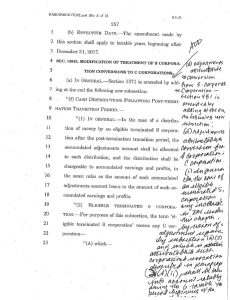Last spring, I wrote about Senator Elizabeth Warren’s college financing proposal for the San Francisco Chronicle. This week, I analyzed for The Conversation former Vice President Joe Biden’s recent proposal to double the maximum Pell Grant as a way of increasing college affordability. The two have taken very different approaches, and assuming they both stay in the race as viable candidates for the Democratic nomination, it will be interesting to see the attention each proposal receives.
tuition
Senator Warren’s college financing proposals
The 2020 campaign for president is already heating up, and the Democratic field includes almost two dozen candidates. One of them, Senator Elizabeth Warren of Massachusetts, recently unleashed a widely-covered proposal offering “free college” and elimination of student debt for millions of Americans. In an op-ed in the San Francisco Chronicle, I analyzed why Warren’s proposal is not in the best interests of the nation.
The reasons behind tuition increases
Like many universities, during the spring semester USF announces its tuition and fee rates for the following academic year and sends the announcement to continuing students (as well as the parents of undergraduate students). This year, we received a lot of pushback from students because we had not included information about why tuition was going up next year. A grassroots group of students formed and mounted a protest during our Board of Trustees meeting earlier this month. Our student newspaper, The San Francisco Foghorn, published an op-ed and staff editorial complaining about the lack of transparency. Continue reading “The reasons behind tuition increases”
Tax reform that harms graduate students and university employees
The competing House and Senate tax reform bills are large, complex, and often difficult to understand. The Senate bill, for example, is a 479-page document that was passed early in the morning last Saturday and that included last-minute, hand-written passages as shown to the right.  There are numerous parts of each bill that have a large impact on colleges and universities in the country, as well as their students. One estimate calculated after the House bill was passed is that if enacted into law, it would cost students and their families $71 billion over the next ten years. Now that both chambers have passed bills, a conference committee will try to hash out the differences and agree on one bill to be passed by both the House and Senate and sent on to President Trump to be signed into law. Continue reading “Tax reform that harms graduate students and university employees”
There are numerous parts of each bill that have a large impact on colleges and universities in the country, as well as their students. One estimate calculated after the House bill was passed is that if enacted into law, it would cost students and their families $71 billion over the next ten years. Now that both chambers have passed bills, a conference committee will try to hash out the differences and agree on one bill to be passed by both the House and Senate and sent on to President Trump to be signed into law. Continue reading “Tax reform that harms graduate students and university employees”
The New York Times misrepresents student debt – again
 As I have written in the past, The New York Times has had a pattern of sensationalizing the status of student loan debt in the country through a series of articles that misrepresent the true status of borrowing. It is a mystery to me why the Times persists in doing so, as they have also published articles that more accurately show the true state of affairs. The most recent misrepresentation appeared last week in an article authored by Kevin Carey, a frequent critic of higher education in this country. Earlier this year I wrote a critique of Carey’s most recent book, The End of College.
As I have written in the past, The New York Times has had a pattern of sensationalizing the status of student loan debt in the country through a series of articles that misrepresent the true status of borrowing. It is a mystery to me why the Times persists in doing so, as they have also published articles that more accurately show the true state of affairs. The most recent misrepresentation appeared last week in an article authored by Kevin Carey, a frequent critic of higher education in this country. Earlier this year I wrote a critique of Carey’s most recent book, The End of College.
In his Times article Carey tells the story of Liz Kelley, a 48-year-old woman who borrowed $26,278 to earn a bachelor’s degree in English in 1994, but whose student loan debt today totals $410,000 – yes, $410,000! As Carey points out, this is a sum of money Ms. Kelley is unlikely to be able to ever pay back given her current career as a teacher at a parochial school. Her total borrowing ballooned because of additional debt she took on for graduate programs (in law, which she didn’t complete, and then education), and the fact that she was infrequently, if at all, actively repaying her loans.
Continue reading “The New York Times misrepresents student debt – again”
Duncan’s higher education legacy

As Arne Duncan, one of the longest-serving Secretaries of Education, announces his forthcoming resignation, observers are starting to reflect on his impact on education policy in the nation. Duncan will most likely be remembered more for his focus on K-12 education, not surprising given his background as the superintendent of Chicago Public Schools, third-largest school district in the country. In that domain, he was known mostly for extending the Bush-era focus on accountability via testing. And it was that focus that led him to be reviled by many in traditional K-12 schools. As education historian and commentator Diane Ravitch wrote in the Huffington Post recently, “It will take years to recover from the damage that Arne Duncan’s policies have inflicted on public education.”
Hillary Clinton’s New College Compact

Hillary Clinton, a candidate for the Democratic nomination for president, recently released a set of policy proposals to address the rising cost of college. While there are many good aspects to her plan, there are also some problems with it. In a recent op-ed on the website of The Conversation, I analyzed Secretary Clinton’s plan and some of the barriers to its enactment.
Awarding financial aid to students earlier
 Grants and scholarships are critical for helping many students afford college. Data from the College Board show that the largest single grant program, the federal government’s Pell Grant program, awarded $33.7 billion to 9.2 million students in the 2013-14 academic year. Without the support of Pell Grants, millions of students across the country would not be able to enroll in college.
Grants and scholarships are critical for helping many students afford college. Data from the College Board show that the largest single grant program, the federal government’s Pell Grant program, awarded $33.7 billion to 9.2 million students in the 2013-14 academic year. Without the support of Pell Grants, millions of students across the country would not be able to enroll in college.
A limitation of Pell Grants for traditional students who are graduating from high school and contemplating attending college, like many other financial aid programs, is that most students do not find out about their eligibility for the grants until late in their senior year in high school. This is often too late for students to take the steps necessary to prepare themselves for college – including preparing academically, financially, and socially – to have an impact on their college going behavior.
Continue reading “Awarding financial aid to students earlier”
Why I won’t sign the petition to cancel all student debt
 As I have written in the past, a lot of attention is currently being paid to the topic of student loan debt in the United States (a couple of representative posts can be found here and here). Earlier this year, President Obama proposed to make community college free for all students, motivated at least in part by concerns over the growing volume of student loan debt in the nation. With the 2016 presidential campaign starting to gear up, there are already indications that student loans will be an important topic of debate.
As I have written in the past, a lot of attention is currently being paid to the topic of student loan debt in the United States (a couple of representative posts can be found here and here). Earlier this year, President Obama proposed to make community college free for all students, motivated at least in part by concerns over the growing volume of student loan debt in the nation. With the 2016 presidential campaign starting to gear up, there are already indications that student loans will be an important topic of debate.
I recently received in my email inbox a request to sign a petition to “forgive all student loan debt” in the country. The email did not come from some fringe group that was an offshoot of the Occupy Movement that first started a few years ago, and included as one of its platforms the elimination of all student loan debt. The email came from the American Federation of Teachers, the second-largest teacher union in the country, representing over 1.6 million members. The AFT, in conjunction with other groups, is calling on President Obama and Congress to wipe out all of the existing $1.3 trillion in loan debt held by current and former college students in the nation.
Continue reading “Why I won’t sign the petition to cancel all student debt”
The “End of College”? Not so fast

A recently-published book, The End of College: Creating the Future of Learning and the University of Everywhere, by New American educational analyst Kevin Carey, has received a lot of media attention. Carey predicts that most colleges as we know them today will likely disappear, and be replaced by online courses that will be widely and freely available to all students. In an op-ed in The Chronicle of Higher Education, I explained why Carey’s prediction is not likely to come to fruition, and if it did, why it would be bad for the nation.